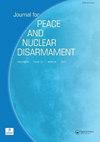Reducing or Exploiting Risk? Varieties of US Nuclear Thought and Their Implications for Northeast Asia
IF 1.4
Q4 INTERNATIONAL RELATIONS
引用次数: 1
Abstract
ABSTRACT This article argues that there is no monolithic “United States perspective” when it comes to theories of nuclear stability, either structurally or during a crisis. Instead, the propensity of American policymakers to use or invest in nuclear weapons is heavily conditioned by their political and ideological orientation. There has always been a rough ideological divide between nuclear hawks (those tending to favor military coercion) and doves (those generally opposing signaling threats of force) in the United States, but the past several decades have seen more diversity in the types of views and preferences expressed in policy circles about strategic stability and the (dis)utility of nuclear weapons. This article categorizes the various US perspectives on nuclear weapons as “arms-controllers”, who seek to reduce risks to strategic stability and view advanced conventional weapons as heightening the risks of nuclear use, “nuclear traditionalists”, who accept the logic of mutually assured destruction, “nuclear primacists”, who believe stability derives from nuclear superiority, escalation dominance, and the willingness to launch damage-limiting nuclear first-strikes, and “future-of-war” strategists, who de-center the role of nuclear weapons in US strategy in favor of a focus on precision-guided conventional munitions and delivery systems. These categorical distinctions, and which group holds the attention of policymakers, matters. The scope for US nuclear weapons use – and the propensity to engage in actions that trigger adversary nuclear considerations – narrows and widens depending on whose logic and preferences prevail both over time and in moments of crisis or shock.降低风险还是利用风险?美国核思想的变化及其对东北亚的影响
摘要本文认为,无论是在结构上还是在危机期间,当涉及到核稳定理论时,都不存在单一的“美国视角”。相反,美国决策者使用或投资核武器的倾向在很大程度上取决于他们的政治和意识形态取向。在美国,核鹰派(倾向于军事胁迫的人)和鸽派(通常反对武力威胁的人)之间一直存在着粗略的意识形态分歧,但在过去几十年里,政策界对战略稳定和核武器的使用表达的观点和偏好更加多样。本文将美国对核武器的各种看法归类为“军备控制者”、“核传统主义者”、,升级的主导地位,以及发动限制破坏的核第一次打击的意愿,以及“战争的未来”战略家,他们将核武器在美国战略中的作用放在中心位置,转而关注精确制导常规弹药和运载系统。这些明确的区别,以及决策者关注的群体,都很重要。美国使用核武器的范围——以及采取引发对手核考虑的行动的倾向——会随着时间的推移以及在危机或震惊时刻,谁的逻辑和偏好占上风而缩小或扩大。
本文章由计算机程序翻译,如有差异,请以英文原文为准。
求助全文
约1分钟内获得全文
求助全文
来源期刊

Journal for Peace and Nuclear Disarmament
INTERNATIONAL RELATIONS-
CiteScore
1.30
自引率
0.00%
发文量
36
审稿时长
12 weeks
 求助内容:
求助内容: 应助结果提醒方式:
应助结果提醒方式:


